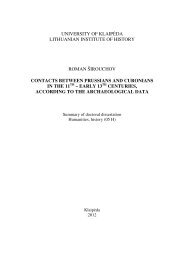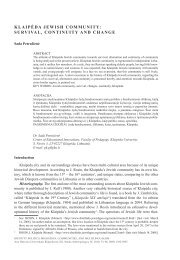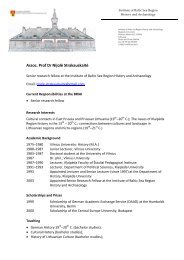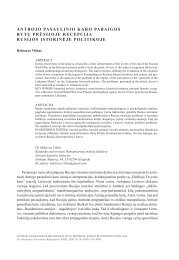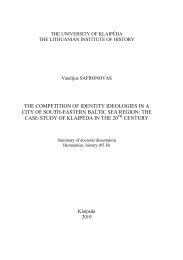See summary of dissertation in English - Baltijos regiono istorijos ir ...
See summary of dissertation in English - Baltijos regiono istorijos ir ...
See summary of dissertation in English - Baltijos regiono istorijos ir ...
You also want an ePaper? Increase the reach of your titles
YUMPU automatically turns print PDFs into web optimized ePapers that Google loves.
<strong>in</strong>g approach <strong>in</strong> historiography, accord<strong>in</strong>g to which corvée was used to<br />
a far lesser extent <strong>in</strong> large landownership on the territory <strong>of</strong> the GDL.<br />
Apart from labour rent (corvée), rent <strong>in</strong> cash and rent <strong>in</strong> k<strong>in</strong>d were<br />
equally important <strong>in</strong> private estates, which fully corresponded with the<br />
dom<strong>in</strong>ant tendencies <strong>of</strong> rent forms <strong>in</strong> Central Europe at that time.<br />
Apart from corvée peasants referred to as tiaglai, the number <strong>of</strong> peasants,<br />
referred to as duokl<strong>in</strong><strong>in</strong>kai, who were imposed both cash and<br />
labour rent, was slightly lower. Due to the absence <strong>of</strong> the fully established<br />
and settled rent, the<strong>ir</strong> situation could be considered as <strong>in</strong>termediary<br />
between duokl<strong>in</strong><strong>in</strong><strong>in</strong>kai (payers <strong>of</strong> rent <strong>in</strong> k<strong>in</strong>d) and č<strong>in</strong>š<strong>in</strong><strong>in</strong>kai<br />
(payers <strong>of</strong> rent <strong>in</strong> cash).<br />
The free peasants <strong>in</strong>cluded <strong>in</strong>to the composition <strong>of</strong> the manorial<br />
familia, the c<strong>ir</strong>cle <strong>of</strong> tiaglai or duokl<strong>in</strong><strong>in</strong>kai, as opposed to, for <strong>in</strong>stance,<br />
certa<strong>in</strong> Polish regions, did not make up a separate personnel<br />
group <strong>in</strong> Samogitia <strong>in</strong> the second half <strong>of</strong> the 16 th century. However, as<br />
<strong>in</strong> other regions <strong>of</strong> Central Europe, the social structure <strong>of</strong> the manor<br />
used to be supplemented by the h<strong>ir</strong>ed labour force at the<strong>ir</strong> expense.<br />
5. The follow<strong>in</strong>g key segments <strong>of</strong> economic structure <strong>of</strong><br />
Samogitian private manors were dist<strong>in</strong>guished by means <strong>of</strong> source<br />
analysis: crop production, stock-rais<strong>in</strong>g, fishery, beekeep<strong>in</strong>g, forestuse,<br />
process<strong>in</strong>g and crafts.<br />
Crop cultivation has been highlighted <strong>in</strong> the study <strong>of</strong> manor production<br />
for a long time. Other structures <strong>of</strong> agriculture have only been<br />
addressed as a marg<strong>in</strong>al phenomenon <strong>in</strong> the research. The 16 th century<br />
European economy witnessed remarkable changes, which determ<strong>in</strong>ed<br />
the<strong>ir</strong> positions <strong>in</strong> the European and even global economic doma<strong>in</strong>. The<br />
reason <strong>of</strong> this growth was the demand for agricultural products <strong>in</strong> the<br />
<strong>in</strong>ternational market. Crop products were among the most marketable<br />
goods.<br />
The system <strong>of</strong> land cultivation was the primary factor <strong>of</strong> success <strong>of</strong><br />
this type <strong>of</strong> farm<strong>in</strong>g. Even though it is believed that a three-field system<br />
was no longer a rare phenomenon <strong>in</strong> the GDL at that time, the division <strong>of</strong><br />
land <strong>in</strong>to wallacks attempted to accelerate its use. Comparatively scarce<br />
data show that the use <strong>of</strong> three-field system was not a universal rule <strong>in</strong><br />
44





